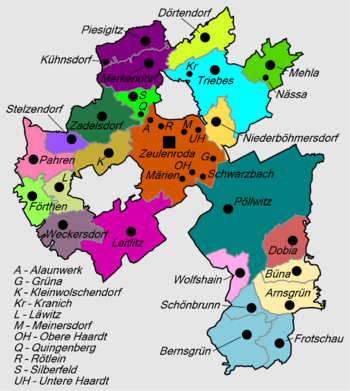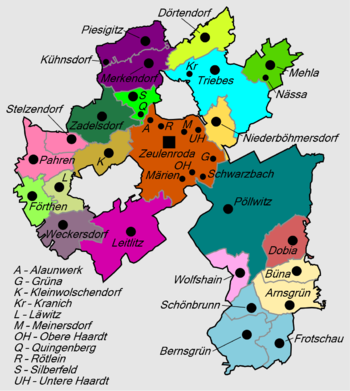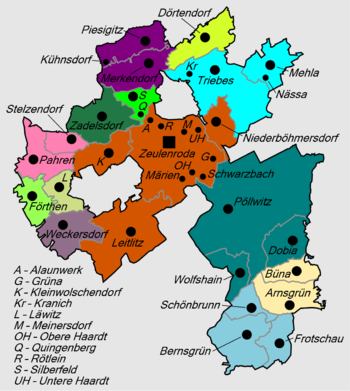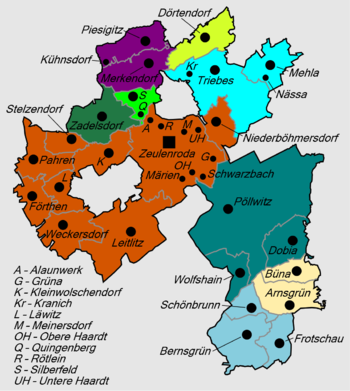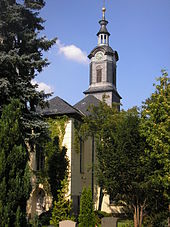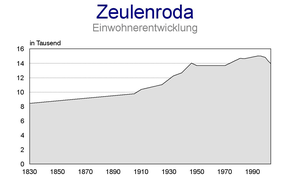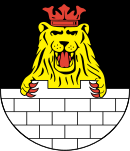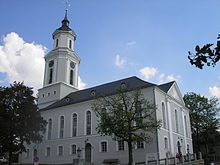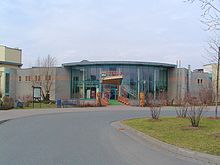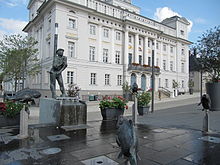Zeulenroda shoot
| coat of arms | Germany map | |
|---|---|---|

|
Coordinates: 50 ° 39 ' N , 11 ° 59' E |
|
| Basic data | ||
| State : | Thuringia | |
| County : | Greiz | |
| Fulfilling municipality : | for Langenwolschendorf for Weißendorf |
|
| Height : | 415 m above sea level NHN | |
| Area : | 135.14 km 2 | |
| Residents: | 16,350 (Dec. 31, 2019) | |
| Population density : | 121 inhabitants per km 2 | |
| Postcodes : | 07937, 07950 | |
| Primaries : | 036628, 036622, 036626 (Merkendorf), 037431 (including Bernsgrün) | |
| License plate : | GRZ, ZR | |
| Community key : | 16 0 76 087 | |
| LOCODE : | DE ZEU | |
City administration address : |
Markt 1 07937 Zeulenroda-Triebes |
|
| Website : | ||
| Mayor : | Nils Hammerschmidt (independent) | |
| Location of the city of Zeulenroda-Triebes in the district of Greiz | ||
Zeulenroda-Triebes is a small town in the east of the Free State of Thuringia in the Thuringian Vogtland with around 16,000 inhabitants. It was created on February 1, 2006 by renaming Zeulenroda after the merger of the cities of Zeulenroda and Triebes , whereby the city of Triebes was dissolved and incorporated into Zeulenroda. Zeulenroda-Triebes is the second largest city in the district of Greiz and has the status of a medium-sized center .
geography

Geographical location
Zeulenroda-Triebes is located in the south-east of Thuringia, right on the border with the Free State of Saxony . The main town of Zeulenroda is on federal road 94 . In terms of nature, the area belongs to the East Thuringian-Vogtland plateau . The center of Zeulenroda is at an altitude of 415 m above sea level. NN (market place). Zeulenroda is therefore also called the city on the heights . Triebes, on the other hand, lies in the valley of the river of the same name . The highest point in the area is the Schöne Höhe (485 m). In the Zeulenroda area there is diabase rock, phyllite , quartzite and clay slate ( alum slate ). The soils in the Thuringian Slate Mountains have a high proportion of fine earth and a high humus content . They are yield stable under the climatic conditions. The Zeulenroda dam is located on the Weida at the gates of Zeulenroda . The Pöllwitz Forest extends around the southeastern district of Pöllwitz .
Neighboring communities
The municipality of Langenwetzendorf , the cities of Greiz , Auma-Weidatal and Hohenleuben as well as the completely enclosed places Langenwolschendorf and Weißendorf border the urban area in the district of Greiz . Zeulenroda-Triebes also borders the neighboring district of Saale-Orla and the Saxon Vogtland district .
City structure
| District | associated places | Remarks |
|---|---|---|
| Arnsgrün-Bernsgrün-Pöllwitz * | Arnsgrün , Büna , Bernsgrün , Dobia , Frotschau , Pöllwitz , Schönbrunn , Wolfshain | Incorporation on July 1, 1999 in Vogtland Oberland , reclassification on December 31, 2012 |
|
Dörtendorf |
April 1, 1999 to Triebes |
|
|
Förthen |
May 1, 1994 to Zeulenroda |
|
|
Kleinwolschendorf |
April 1, 1992 to Zeulenroda |
|
|
Läwitz |
May 1, 1994 to Zeulenroda |
|
|
Leitlitz |
July 14, 1993 to Zeulenroda |
|
|
Mehla * |
Mehla |
April 6, 1994 to Triebes |
|
Merkendorf, Piesigitz |
December 1, 2011 to Zeulenroda-Triebes |
|
|
Niederboehmersdorf |
July 1, 1992 to Zeulenroda |
|
|
Pahren |
May 1, 1994 to Zeulenroda |
|
|
Quingenberg , Silberfeld |
December 1, 2011 to Zeulenroda-Triebes |
|
|
Stilt village |
January 1, 1974 to Pahren |
|
|
Drive * |
Instinct |
February 1, 2006 |
|
Weckersdorf |
May 1, 1994 to Zeulenroda |
|
|
Zadelsdorf |
December 1, 2011 to Zeulenroda-Triebes |
* Districts have district mayors and district councils
In addition to these in the main statute called the town Zeulenroda-Triebes districts exist u. a. the localities Märien , Meinersdorf , Grüna , Rötlein and Kranich .
In addition, Zeulenroda-Triebes has the status of a fulfilling municipality for Langenwolschendorf and Weißendorf .
history
Around the 9th century, the Sorbs began to settle the area around today's city. Before that, the region was only a transit area. In 1209 Triebes - a Sorbian town foundation - was first mentioned as Tributz . In the first half of the 13th century, the bailiffs of Weida founded the place Zeulenroda. Zeulenroda was first mentioned as Zulenrode on August 14, 1325 . In a document from the Saalburg nunnery on the Holy Cross, all villages and farmers are named by name, which are subject to interest in the monastery with real estate. It says: In Zulenrode unus mansus, quem colit ... dictus Dressel. Thanks to its convenient location at the intersection of the Weida - Hof and Auma - Elsterberg streets , the settlement developed into a lively market town. On September 26, 1438 Zeulenroda was granted city rights. In 1500 Zeulenroda was pledged to Messrs. Reuss (Plauen line). With the loss of the hinterland, the city's citizens became impoverished. In 1564 the Reussian area was divided into a younger , middle and older line , to which Zeulenroda belonged. Triebes, however, belonged to Reuss-Schleiz until 1848 , then until 1918 to the Principality of Reuss Younger Line .
Around 1750 Zeulenroda developed into a stronghold of stocking knitting and achieved world fame well into the 19th century. In addition, the carpentry trade as well as the rubber knitwear and knitwear production gained in importance. According to the designs of the factory owner Christian Heinrich Schopper, today's town hall was built in the classical style from 1825 to 1827 , into which the Sparkasse Zeulenroda, founded in 1851, moved in 1880 . The German war brought the principality Reuss older line, which stood on the side of Austria in 1866, to the brink of dissolution. After the war, Reuss older line joined the North German Confederation and became part of the German Empire in 1871 . In 1883 the railway line of the Mehltheuer-Weidaer Railway Company that ran through Zeulenroda and Triebes was inaugurated. The city only got a direct connection with the railway line Zeulenroda und Bf - Zeulenroda ob Bf, which opened in 1914 .
In 1919, the two Russian states formed the People's State of Reuss , which was incorporated into the newly formed state of Thuringia as early as 1920 . In 1919 Triebes received city rights.
In the Zeulenroda city council elections on December 4, 1932, the NSDAP , which stood for the first time, achieved 9 out of 25 seats. Numerous resettlers came to the city during and after the Second World War . The high-frequency laboratory of the Physikalisch-Technische Reichsanstalt under its director Adolf Scheibe had been relocated to Zeulenroda when the area bombing began on Berlin . In an attack by the US Air Force on Zeulenroda on March 17, 1945, eight people were killed. Overall, Zeulenroda was largely spared from the war. The 3rd US Army occupied the city on April 16, 1945 without fighting. From July 1, 1945, the city was under Soviet administration . When the Americans withdrew from Thuringia, they evacuated the high-frequency laboratory, along with its employees and their families, to Heidelberg . The Kneusel and Lang machine works were dismantled as reparations to the Soviet Union .
After the founding of the GDR , Zeulenroda became the district town of the Zeulenroda district in the Gera district in the course of the district reforms in the GDR .
On August 13, 1973, the front part of the dam bridge to Auma that was under construction collapsed . Four people died and five were seriously injured. The work (for the first time a bridge in a free porch) took place under deadline pressure and under pressure to save steel. Since the accident occurred on the anniversary of the construction of the wall, sabotage was initially suspected. The chief engineer and two employees were sentenced to several years in prison by the Gera District Court in May 1974, but were then acquitted by the GDR Supreme Court . In the course of the investigation, it was ultimately found that outdated design specifications were the cause. On June 20, 1975, the new drinking water dam on the Weida was officially handed over.
On October 19, 1989, a political demonstration against the SED dictatorship took place in Zeulenroda for the first time . About 3,000 people took part in it. The SED district leadership resigned on November 13th. In the first free local elections after the fall of the Wall on May 6, 1990, Frank Steinwachs (CDU) Zeulenrodaer and Martina Schweinsburg (CDU) became district administrator of the Zeulenroda district . In Triebes, Gerhard Helmert (CDU) was elected mayor and remained so until the merger with Zeulenroda. The state- owned enterprises were privatized, and unemployment rose dramatically. VEB WEMA (machine tool construction), Möbelkombinat, Rotpunkt (rubber goods) and Elastic Mieder (lingerie), which were based in the GDR era, were gradually dissolved as a result of the reunification; new companies, including Bauerfeind AG , settled on new commercial sites.
Due to the Thuringian district reform , Zeulenroda lost its district town status in 1994. A declining population and the possible loss of Zeulenroda status as a middle center allowed Triebes and Zeulenroda to intensify their long-term cooperation. In 2005, both city councils passed resolutions on the merger. The Thuringian Parliament decided on 26 January 2006 with a reorganization law, the resolution of the city drive and the inclusion of Zeulenroda February 1, 2006 and the amendment of the town name in Zeulenroda-Triebes. The Free State of Thuringia supported this voluntary merger with a one-time donation of 1 million euros.
In 2008 Zeulenroda-Triebes applied unsuccessfully to host the 2013 State Horticultural Show . On December 1, 2011, the municipalities of Merkendorf, Silberfeld and Zadelsdorf were incorporated into Zeulenroda-Triebes . In 2012 the neighboring municipality of Vogtland Oberland was dissolved and its districts Arnsgrün (with Büna ), Bernsgrün (with Frotschau and Schönbrunn ) and Pöllwitz (with Dobia and Wolfshain ) incorporated into the town of Zeulenroda-Triebes. These were merged to form the Arnsgrün-Bernsgrün-Pöllwitz district.
Population development of Zeulenroda
In 1908 the population of Zeulenroda exceeded the 10,000 mark. In 1946 the city had grown to over 14,000 inhabitants due to the large number of resettlers who had lost their homeland as a result of the chaos of war and had come to Zeulenroda. At the beginning of the 1990s, over 15,000 people lived in Zeulenroda. In recent years, the number of residents has declined slightly due to demographic developments and people moving away.
Development of the population (from 1960 December 31) :
|
1830 to 1950
|
1960 to 1998
|
1999 to 2005
|
- Data source from 1994: Thuringian State Office for Statistics
1 October 29th
2 August 31st
Population development of Triebes
The population of Triebes has remained relatively constant after reunification, but this is due to the incorporation of Mehla and Dörtendorf. It fluctuated between 4,000 and 4,300 inhabitants.
Development of the population (from 1994 December 31st) :
|
|
|
- Data source from 1994: Thuringian State Office for Statistics
Population development of Zeulenroda-Triebes
Development of the population (December 31) :
|
|
- Data source: Thuringian State Office for Statistics
1 before the two cities merged
politics
City council
The following parties are represented in the city council after the local elections on May 26, 2019 :
| Party / list | Seats | +/- |
| Christian Democratic Union of Germany (CDU) | 5 | - 6 |
| Alternative for Germany (AfD) | 4th | + 4 |
| The left | 3 | - 2nd |
| Social Democratic Party of Germany (SPD) | 1 | - 2nd |
| Free Democratic Party (FDP) | 1 | ± 0 |
| PRO Region Zeulenroda-Triebes | 7th | + 7 |
| Voting Community Thuringian Vogtland (TV) | 2 | ± 0 |
| Citizens' Initiative Zeulenroda (BIZ) * | 1 | - 1 |
| total | 24 |
* BIZ: Citizens' initiative for socially acceptable taxes and fair performance in Zeulenroda and the surrounding area. V.
mayor
As part of the local elections in Thuringia 2018 , the first round of the mayoral election in Zeulenroda-Triebes took place on April 15, 2018. Five candidates competed against each other. With a turnout of 60.5%, the non-party candidate Nils Hammerschmidt won the most votes in the first ballot with 33% in front of Volker Emde (CDU, 26.5%), incumbent Dieter Weinlich (non-party, 20.1%), Eike Wachowiak ( AfD, 13.7%) and Diana Skibbe (Die Linke, 6.8%).
In the runoff election on April 29, 2018, the non-party Nils Hammerschmidt prevailed with a turnout of 51.7% with 67.2% ahead of CDU candidate Volker Emde , who received 32.8% of the votes.
- Previous mayor of the city of Zeulenroda-Triebes or Zeulenroda
The town charter of 1438 did not yet have a permanent mayor. The office rotated between several councils. B. Gottlob Harnisch, who was in office from 1762, is the first permanent mayor of Zeulenroda. According to the municipal ordinance of 1871, there was a two-person city council made up of first (listed below) and second mayor.
|
|
Election results
For the 2009 Bundestag election , 14,016 people were eligible to vote in Zeulenroda-Triebes. The turnout was 53.9%.
| Political party | City Council 1999 |
City Council 2004 |
City Council 2009 |
State Parliament 1999 |
State Parliament 2004 |
State Parliament 2009 |
Bundestag 2002 |
Bundestag 2005 |
Bundestag 2009 |
||
|---|---|---|---|---|---|---|---|---|---|---|---|
| CDU | 49.9% | 54.1% | 42.6% | 53.7% | 47.9% | 31.9% | 30.8% | 26.2% | 30.8% | ||
| SPD | 19.1% | 11.5% | 15.4% | 16.2% | 12.9% | 18.4% | 39.3% | 27.0% | 15.9% | ||
| PDS / The Left | 15.9% | 18.2% | 20.0% | 21.7% | 25.5% | 29.5% | 16.4% | 27.3% | 30.9% | ||
| BIZ | 8.1% | 12.8% | 12.8% | - | - | - | - | - | - | ||
| FDP | 2.5% | 3.4% | 9.2% | 0.9% | 3.6% | 7.7% | 5.6% | 9.0% | 10.9% | ||
| Alliance 90 / The Greens | - | - | - | 1.5% | 3.6% | 5.5% | 4.0% | 4.4% | 5.3% |
In the case of state and federal elections, the results of the state or second votes are given.
coat of arms
The coat of arms of Zeulenroda-Triebes shows a silver battlement wall on a black field . A gold, armored lion with a red crown sits enthroned above it. The wall is covered with a little golden plate in which a black, red armored lion's paw, which breaks out, holds a passion cross made of four jute cords interwoven in the middle . This label corresponds to the coat of arms of the former town of Triebes and was integrated into the Zeulenroda coat of arms after its incorporation. The original Zeulenroda coat of arms (without a label with a Passion Cross) was granted in this form with the town charter on September 26, 1438.
Town twinning
Zeulenroda has been twinned with Giengen an der Brenz (Baden-Württemberg) since 1990 . Triebes has signed partnership agreements with Neunkirchen am Sand (Bavaria), Wies (Austria), Sainte-Florine (France) and Kostelec nad Orlicí (Czech Republic). There are also friendly relationships with four other cities.
Culture and sights
Museums
The municipal museum houses numerous exhibits on the history of the place, including the city letter from 1438. A focus is on period furniture from Zeulenroda production.
Buildings
The townscape is shaped by the beautiful town hall in the classical style. On the tower of the town hall is a statue of Themis , the Greek goddess of justice, who is called Gette by the locals . In front of the town hall, on the market square, is the Karpfenpfeifer fountain, which refers to the nickname of the Zeulenroda citizens “Karpfenpfeifer”. The Trinity Church and the Kreuzkirche are also located in the city center . The Waikiki Bathing World , the Municipal Museum, the Winkelmann House in Triebes, the game reserve and the dam on the Weida are also worth a visit . Numerous hiking trails, including a planetary hiking trail and the circular trail around the dam, which has been recognized by the German Hiking Association as a quality trail hiking in Germany , invite you to explore the area.
Memorials
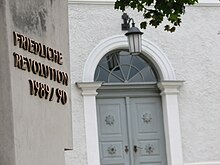
- A memorial on Rosa-Luxemburg-Platz commemorates the victims of the Second World War.
- In the old people's home on Pausaer Straße , a plaque has been used since 1957 to commemorate the Social Democrat Franz Philipp , who was murdered in the Gestapo prison in the Weimar Marstall in 1943 after repeated persecution . The home bore his name until 1989.
- Since 1951 a VVN memorial near the former upper train station has been commemorating the victims of the fascist concentration camps .
- A grave with a memorial stone in the cemetery in the Weckersdorf district commemorates three unknown Soviet prisoners of war who were victims of forced labor.
- Since 1994, a memorial stone in Quingenberg has been commemorating the four workers who died in 1973 when the dam bridge under construction collapsed .
- A memorial stone in front of the Dreieinigkeitskirche has been commemorating the Peaceful Revolution in the GDR since 2009 .
Parks
The "Rabensleite" animal enclosure, located in a wooded area on the outskirts of Zeulenroda, houses various - predominantly native - species (e.g. red deer, eagle owls, sheep, goats, kangaroos) and is open to the public. Admission is free. In the center of the city is the Pushkin Park, which is equipped with play equipment for children.
Sports
With the Waldstadion, Zeulenroda-Triebes has a sports facility with three places for football, athletics and fire fighting . With its own riser tower , the fire brigade can even climb the hook ladder . There is a sports facility for football and tennis in Triebes. The Waikiki bathing world with an attached communal indoor pool and several gyms offer further sporting activities. The top-class football club in the city is FC Motor Zeulenroda , which was relegated from the Thuringian league to the state class in 2011. The table tennis players and the chess ladies, who already played in the 1st Bundesliga, are also nationally successful . Zeulenroda is traditionally the destination of the International Thuringia Tour of Women . The annual athletics meeting in the Waldstadion and the Crosstriathlon Vogtland Challenge are also important.
Regular events
Various festivals, including the Culture Night and the City Festival, are popular with the guests.
Economy and Infrastructure
At the end of the 19th century the knitwear industry was dominant in Zeulenroda. Was known z. B. the company Julius Römpler, which manufactured rubber textiles. Triebes was the location of jute processing and mechanical engineering. During the GDR era, VEB WEMA (machine tool construction), Möbelkombinat, Rotpunkt (rubber goods) and Elastic Mieder (lingerie) were based in Zeulenroda and employed several thousand people. Today the service sector, trade and craft, medical technology as well as companies of the wood and metal processing industry are represented. The city on the dam has hopes of increased tourist importance. The unemployment rate is 6.8% (as of December 2015).
traffic
Zeulenroda-Triebes is conveniently located on the B 94 between the A 4 Eisenach - Dresden , A 9 Berlin - Nuremberg and A 72 Chemnitz - Hof motorways and is only about 20 minutes by car from the Triptis and Schleiz junction of the A 9 and 30 minutes from the motorway exit Reichenbach in the Vogtland of the A 72.
Zeulenroda-Triebes has the Triebes stop and the Zeulenroda lower station (historic reception building has since been demolished) on the Weida – Mehltheuer railway line , on which the Erfurt Railway operates. Since the timetable change on December 11, 2011, the Pöllwitz and Bernsgrün stops are no longer served.
Until 1996 there was also the 3.66 km long Zeulenroda light rail , which connected the lower station with the upper station in the middle of the city . This route, which opened in 1914, lost passenger traffic as early as 1974, but it was reopened on September 23, 1991. On June 2, 1996, the regional rail transport on this route was finally canceled by the state of Thuringia and the route was dismantled.
The public transport in and around Zeulenroda-Triebes is mainly from the PRG Greiz operates nine bus lines. This also includes a pure city line that leads through the Zeulenroda city center on a tour. Lines 25, 28 and 34 run every half hour between Zeulenroda and Triebes. In addition, Zeulenroda is linked to the Vogtlandkreis by two lines and one to Schleiz.
| line | operator | Line course | Frequency (Mon-Fri) | connections |
|---|---|---|---|---|
| 24 | PRG | Zeulenroda - Göttendorf - Wellsdorf - Greiz | Every two hours | |
| 25th | PRG | Zeulenroda - Triebes - Langenwetzendorf - Greiz (- Reichenbach ) | Hourly ( LB ) | Drive: from / to Gera / Leipzig Reichenbach: from / to Chemnitz / Dresden |
| 28 | PRG | Zeulenroda - Triebes - Hohenleuben - Hohenölsen (- Gera ) | Every two hours | Zeulenroda unt. Bf :: from / to Hof Gera: from / to Jena / Erfurt |
| 30th | PRG | City traffic Zeulenroda | Hourly | |
| 34 | PRG | Zeulenroda - Triebes - Staitz / Hohenölsen - Weida | Every two hours | Weida: from / to Gera |
| 35 | PRG | Zeulenroda - Pahren - Förthen / Stelzendorf - Zeulenroda | Every two hours | |
| 36 | PRG | Zeulenroda - Pöllwitz - Pausa - Bernsgrün - Arnsgrün - Dobia | ||
| 40 | PRG | Zeulenroda - Auma - Triptis | Hourly ( LB ) | Triptis: from / to Saalfeld / Gera |
| 41 | POB | Zeulenroda - Pausa - Mühltroff - Schönberg - Mehltheuer | Every two hours | Mehltheuer: from / to Falkenstein |
| 42 | POB | Zeulenroda - Pausa - Mehltheuer - Syrau - Plauen | Every two hours | Plauen: from / to Hof / Dresden |
| 45 | PRG | Zeulenroda - Merkendorf - Stelzendorf - Auma - Staitz | ||
| 132 | KomBus | Zeulenroda - Schleiz | Every two hours |
The nearest international airports are in Leipzig, Dresden, Erfurt and Nuremberg.
Established businesses
The important companies in Zeulenroda-Triebes include the Bauerfeind Group, Raster-Zeulenroda Werkzeugmaschinen GmbH, Zeulenroda Präzision Maschinenbau GmbH, neuform Türwerk Hans Glock GmbH, Fein-Elast Umspinnwerk GmbH, Solamagic GmbH, the metal foundry Heinz Brückner, FEFA Fenster & Fassaden Produktions GmbH, TRIMA Triebeser Maschinenbau GmbH and Holz Neudeck GmbH. Largest employer in the city with more than 1,100 employees, the under the leadership of Hans B. Bauerfeind standing Bauerfeind AG (manufacturer of medical auxiliary products). Its 53 m high administration building is the first high-rise building in Thuringia since the reunification of Germany.
media
A local edition of the Ostthüringer Zeitung for Zeulenroda-Triebes and the surrounding area appears as a regional newspaper .
education
In Zeulenroda-Triebes there are elementary and regular schools at four locations, the Friedrich-Schiller-Gymnasium , the state support center, a vocational school and the municipal music school "Fritz Sporn", a branch of the Greiz Adult Education Center and two libraries.
Personalities
Honorary citizen
- Gerhard Helmert, last mayor of Triebes
- Friedrich Reimann (1896–1991), hunting and animal painter
- Johannes Schaub (1919), 1981 initiator of the Heimatblatt Der Karpfenpfeifer
- Hans B. Bauerfeind (* 1940), CEO of Bauerfeind AG
- Peter Herda (1938–2014), former deputy mayor
sons and daughters of the town
In the places that today belong to the town of Zeulenroda-Triebes, the following people of supraregional importance were born:
- Georg Kresse (1604-1641), Bauer General of the Thirty Years' War , was probably in Dörtendorf born
- Johann Christian Gottlieb Ackermann (1756–1801), physician, chemist
- Friedrich August von Gebler (1781–1850), physician, botanist, zoologist, entomologist
- Christian Heinrich Schopper (1787–1864), stocking manufacturer; drew designs for the town hall and church
- Ehregott Grünler (1797–1881), portrait painter (among others by Goethe )
- Gustav Schreck (1849–1918), Thomaskantor in Leipzig
- Heinrich Seeling (1852–1932), architect of numerous theaters (e.g. Theater am Schiffbauerdamm in Berlin , Theater in Gera )
- Fritz Wächtler (1891–1945), National Socialist politician
- Adolf Scheibe (1895–1958), developer of the quartz watch in Germany
- Hans B. Bauerfeind (* 1940), CEO of Bauerfeind AG
- Friedrich Schenker (1942–2013), composer
- Gerd Schenker (* 1948), drummer
- Jürgen Raab (* 1958), soccer player and coach
- Thomas Barth (* 1960), racing cyclist
- Henning Bürger (* 1969), soccer player and coach
- Doreen Dietel (* 1974), actress
- Thomas Nitzsche (* 1975), politician (FDP), Lord Mayor of Jena
- Alexander John (* 1986), hurdler
- René Enders (* 1987), track cyclist
- Michéle Rödel (* 1987), opera and concert singer
Others
dialect
Zeulenroda-Triebes lies in the distribution area of the southeast Thuringian dialect , which belongs to the Thuringian-Upper Saxon dialect group . The Zellreder stories are known in Zeulenroda, short folk tales in Zeulenroda dialect, which are predominantly settled in the petty bourgeois milieu. They first appeared in the local supplement of the Reussischer Anzeiger . Later they were published several times in book form and as audio book CD. A language example (from: Müller, Herbert. Zellreder Geschicht'n (2005). P. 48):
- Yesterday I worried, and if I hadn't really known the Frea who cooked mrsch, I wouldn't have believed it. Ne suwas, everything that happens su heitzetoche. ("I heard something yesterday, and if I didn't know the woman who told me so well, I wouldn't have believed it. No, something like that, which everything happens these days.")
Carp piper legend
According to a legend, Zeulenrodaers once had to help the princely lords in Greiz to fish the castle pond. As a reward, they were invited to an evening carp dinner. But since the Greiz carp tasted of mud because of the polluted ponds and the Zeulenrodaers, who were known for their good carp from their own ponds, did not eat them, one of them vented his displeasure. He got up and shouted: “We don't give a damn about your carp!” Since that day the citizens of Zeulenroda have been nicknamed “Karpfenpfeifer”.
MS Zeulenroda
In 1966 the wooden freighter Zeulenroda was launched in the Rostock VEB shipyard Neptun . The ship of the GDR merchant fleet went primarily to the ports of the White Sea . After the end of the GDR, the ship was sold abroad and renamed.
Individual evidence
- ^ Population of the municipalities from the Thuringian State Office for Statistics ( help on this ).
- ↑ Manfred Graf: Organization of the cooperative plant production with a high proportion of grassland in the southeast Thuringian slate mountains, shown at the KOG Lobenstein. Dissertation at the UNI Jena, 1970, pp. 1–144
- ↑ Jan Eik and Klaus Behling : classified. The greatest secrets of the GDR . Verlag Das Neue Berlin, Berlin 2008. ISBN 978-3-360-01944-8 . Pp. 140-141
- ↑ StBA: Changes in the municipalities in Germany, see 2006
- ↑ www.zeulenroda-triebes.de ( Memento of the original from March 9, 2014 in the Internet Archive ) Info: The archive link was inserted automatically and has not yet been checked. Please check the original and archive link according to the instructions and then remove this notice.
- ↑ 2014 city council election , accessed on August 8, 2014.
- ↑ Thuringian State Office for Statistics: City council election 2019 in Thuringia - final result for Zeulenroda-Triebes , accessed on June 3, 2020
- ↑ Archive link ( Memento of the original dated May 12, 2014 in the Internet Archive ) Info: The archive link was inserted automatically and has not yet been checked. Please check the original and archive link according to the instructions and then remove this notice.
- ↑ City partnerships on the city's website, accessed on April 16, 2019
- ↑ Michéle Rödel biography
literature
- Wolfgang Theilig: Zeulenroda-Triebes - The Lexicon of a City in Thuringia 1100-2006 , 2006
- Heinz Frotscher: Stadt auf der Höhe , Bauer photosetting, 1995
- Heinz Frotscher: Pictures of my city , 2005
- Gottfried Thumser: Taverns, cafés, hotels and restaurants in Alt-Zeulenroda , 2012






